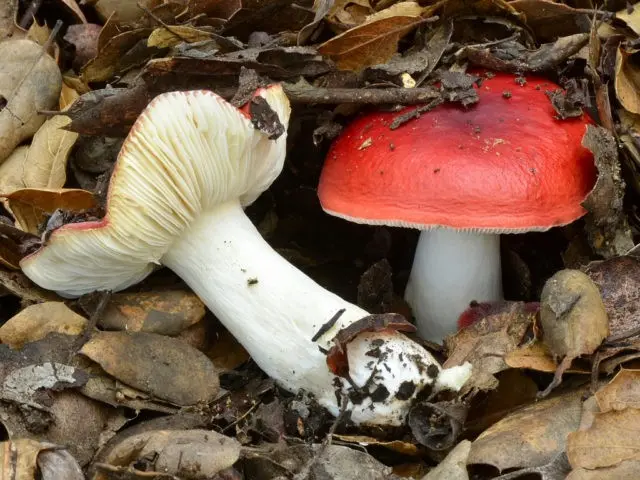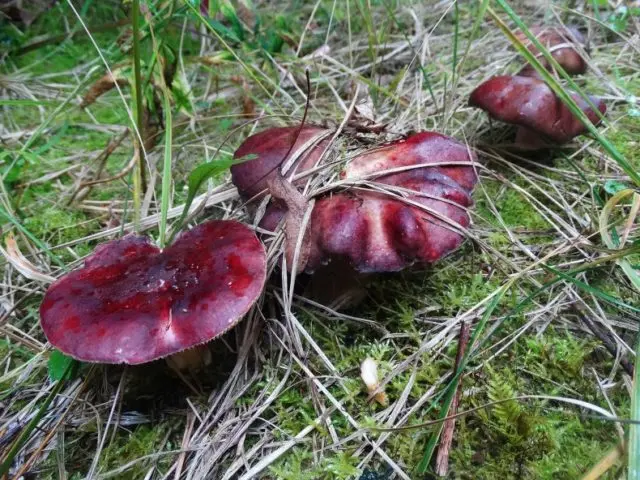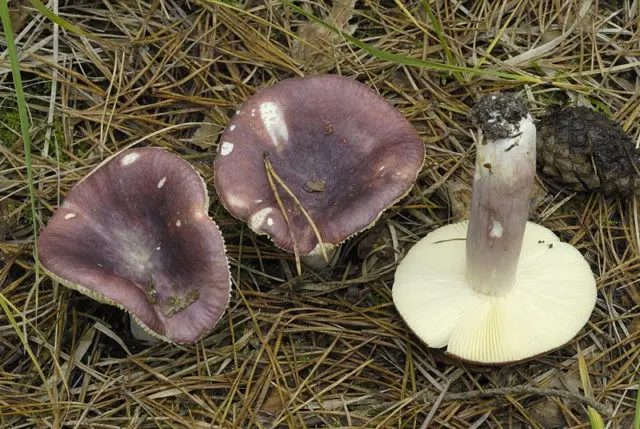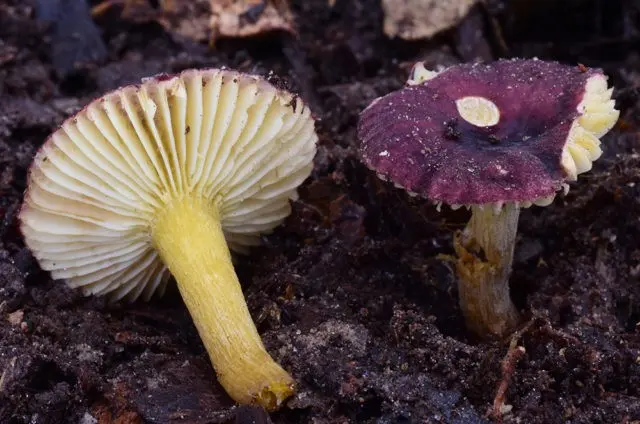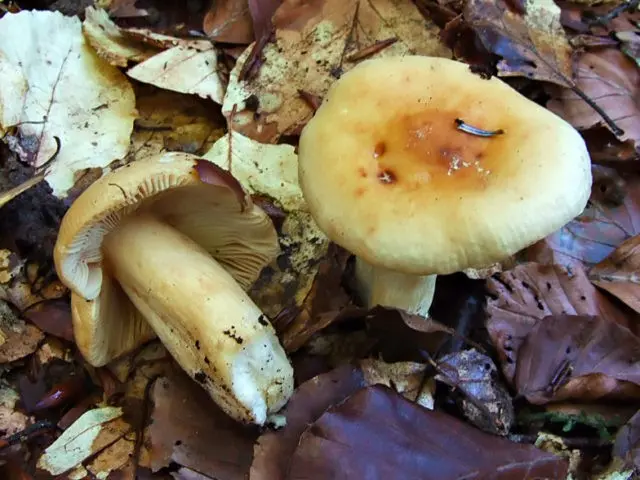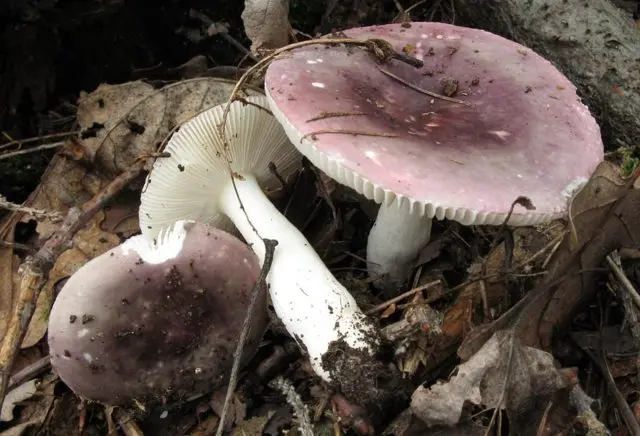Contents
- Are there false russula
- What can be confused with russula
- How to distinguish a false russula
- Photo and description of inedible russula
- How to distinguish russula edible from inedible
- Is it possible to get poisoned with russula
- Symptoms and signs of russula poisoning
- What to do if you are poisoned by poisonous russula
- Conclusion
Russula is a large group of agaric mushrooms. Among them there are edible and poisonous species. Russula, which can be eaten, are distinguished by good taste and ease of preparation. In nature, there are also inedible mushrooms, the appearance of which resembles useful varieties. The differences between these groups are clearly visible in the photo of edible and inedible russula.
Are there false russula
Russula are tasty and healthy representatives of the mushroom kingdom. They are valued for their taste, rich composition and universal use. This group also includes species that are classified as inedible due to their bitter taste. Therefore, they are often called false, although they also belong to the Russula genus.
Other inedible varieties that have their own names are considered false russula. Most of these twins are poisonous and deadly to life. Russula and pseudorussula are similar in appearance to the structure of the fruiting body and color.
What can be confused with russula
False twins have characteristics that distinguish them from edible mushrooms. Their flesh contains harmful toxins that can cause poisoning. In some cases, false mushrooms are fatal.
Death cap
A poisonous species with a bell-shaped or flat cap up to 11 cm in size. One of the most dangerous mushrooms for humans. Its color is white, light green, olive, gray. The leg is thin, up to 12 cm long and 2 cm in diameter. There is a thickening at the base. The main difference between russula and pale grebe is the different shape of the leg, the presence of a poisonous variety of a ring.

Amanita muscaria
An inedible agaric mushroom with a large hat up to 20 cm in size. Its color is bright orange or red. There are white flakes on the surface. In a young mushroom, they are absent, which is the reason for the confusion with russula. The leg of the fly agaric is higher, reaches 8 – 20 cm. The pulp of the false twin is poisonous, causes poisoning and hallucinations.

Brown-yellow talker
False inedible twin, having a hat ranging in size from 3 to 10 cm. Its shape is convex or depressed, with curved edges. Coloring – yellowish, ocher or orange. Narrow plates are located often. Leg – thin, up to 5 cm long, tapering to the base. The fruit body is dense, light in color. The talker contains poisonous toxins.
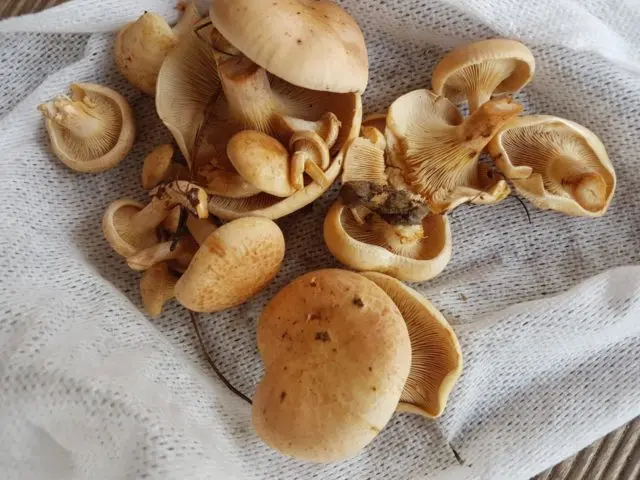
Entoloma poisonous
The poisonous counterpart of russula, which, when ingested, causes severe intestinal upset. Its upper part is up to 20 cm in size, with a large tubercle, gray-brown or yellowish in color. Leg – dense, white, curved. This false twin is distinguished by an unpleasant odor; in young specimens, the smell is powdery.
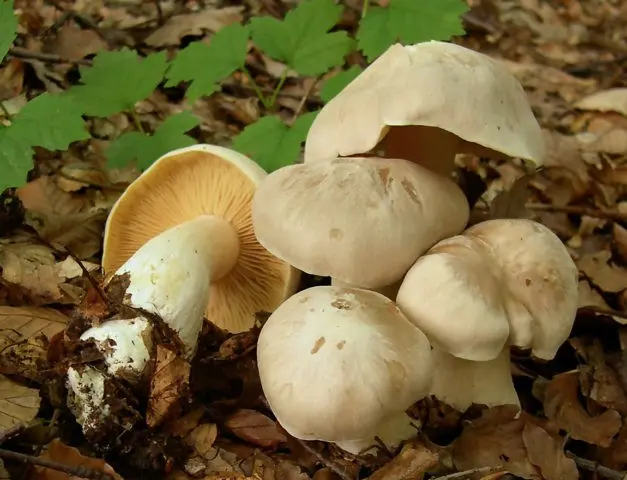
Hebeloma sticky
An inedible poisonous twin, which is distinguished by a hat with a diameter of 3 to 10 cm. Its color is yellow-brown, there is a darker tubercle in the center. Sometimes hebeloma acquires a brick red color. Its leg is long, thin, reaches a height of 3-10 cm. Gebeloma grows in groups under aspens, oaks, birches, in glades and edges. It ripens from September to November.

Stropharia crowned
A poisonous mushroom that looks like a russula in appearance. In young specimens, the conical cap gradually becomes flat. The surface is smooth, yellow, with plates of a darker color, flakes are located along its edges. The size of the upper part is 2 – 8 cm. The leg is cylindrical, tapering towards the base. Stropharia is inedible and dangerous to humans. It grows singly or in rare groups on plains and meadows.
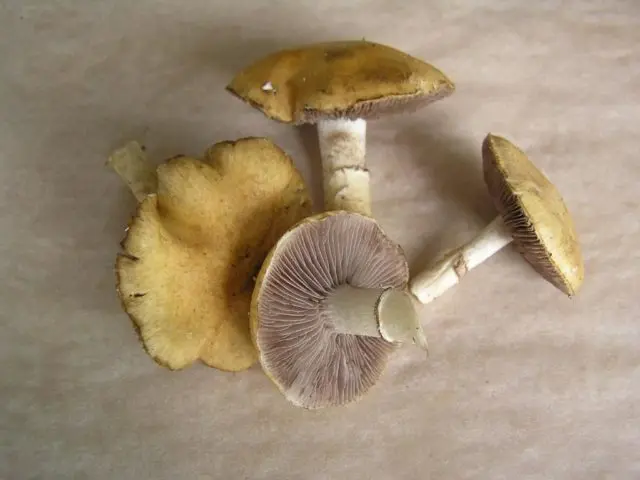
Cobweb lazy
A false twin of russula with a small cap up to 7 cm in diameter. Its shape is slightly convex or prostrate. On the surface are red or orange scales. The pulp of the mushroom is dense, inedible, yellowish, with an unpleasant odor. The leg is short and thick, up to 6 cm long. The cobweb is found in September and October, in wet areas, under birches and pines.

Mycena pink
Mycena is a poisonous mushroom similar to russula. Its hat is small, up to 6 cm in size, bell-shaped or flat. The fruit body is smooth, pink in color, has a pungent odor. The leg is thin, up to 10 cm long. The false twin bears abundant fruit from July to November. Often grows under beech or oak, singly or in small groups.
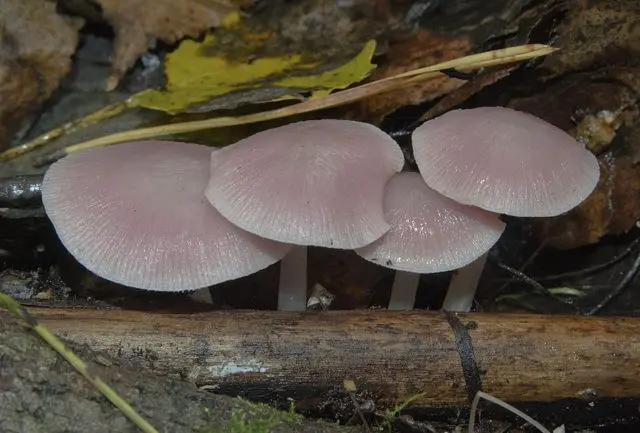
How to distinguish a false russula
To distinguish a false russula from a real one, you need to know the features of each type. Most often, edible species are confused with fly agarics and grebes. These poisonous mushrooms are most common in Our Country.
Fly agaric is distinguished from russula by white plates, an extended leg near the base, and the presence of a white ring. At the same time, the upper part of the false twin is more convex.

The greatest danger is the pale grebe, which belongs to the poisonous category. The differences between mushrooms lie in the structure of the fruiting body. In russula, the leg is cylindrical, while in the grebe it is thinner and longer, has veins and a ring. You can distinguish russula from grebe by the hat. The false twin has a film under it.

Photo and description of inedible russula
Russula unite a large group, among which there are poisonous species. The pulp of inedible mushrooms contains toxins. Because of them, the product has a bitter taste and disrupts the stomach.
Inedible varieties of russula:
- Meira, or conspicuous. It differs in a hat measuring 3 – 9 cm, has a blood-red color. With age, it becomes pinkish. Its plates are frequent, grow to the leg. They are whitish or light beige in color. Leg – cylindrical, strong, white. It has a fruity aroma and is very pungent in taste. The species belongs to the inedible category due to its bitter taste. When raw mushrooms are consumed, signs of poisoning appear.

- Coming. Red poisonous russula, which is determined by the color of the cap. The color of this mushroom representative is dark, with a purple or cherry tint. The species is found in coniferous forests. The cap is 5 to 10 cm in size, fleshy, with a shiny surface. In older specimens, its edges are wrapped up. Thin, white plates gradually acquire a yellow tint. The leg also has a purple tint. Firm, fleshy flesh becomes more brittle with age. The Kele variety grows singly or forms small groups. The aroma of the mushroom is pleasant, fruity. The taste of russula Kele is caustic, so it is classified as an inedible variety.

- stinging. In young representatives of this species, a convex hat with ribbed edges gradually turns into a prostrate and bumpy. The shiny skin becomes sticky in rainy weather. The color of the cap is from pale pink to deep red. On the surface they have white or yellowish spots. The spongy flesh has a fruity or tangy flavor. Russula is classified as false because of its pungent taste.

- Sardonyx, or yellowing. In this species, the cap has a size of 4 to 10 cm. Its color is red with a brown or purple tint, sometimes greenish. The plates are frequent, bright yellow. The pulp is firm, yellowish, with a pungent taste. The species is classified as inedible due to its bitter taste. Grows under a pine, differs in late appearance. When exposed to ammonia, the russula acquires a red tint.

- False blushing. According to the photo and description, false russula is distinguished by a convex and outstretched hat. There is a recess in the center. The color is purple, with lilac and brown undertones. Furrows along the edges of the cap. The flesh is white-red, with a bitter aftertaste. False russula grows in groups in spruce and pine forests.

- blood red. A representative of this species has a convex or flat hat ranging in size from 4 to 10 cm. Its color is rich, bright red, burgundy. Leg – cylindrical, with a red tint. The pulp is pungent in taste, which is why the variety belongs to the inedible category. Raw mushrooms cause poisoning, so they are often considered false russula.Attention! Blood-red russula are found in Eurasia, North America, Australia. They prefer coniferous and mixed forests, where they form mycorrhiza with pines.

- bilious. An inedible species with a bitter taste. Its hat is 4-10 cm in size, yellow in color, sometimes has a beige tint. The peel becomes sticky in high humidity. Rare plates adhere to the stem. The pulp is white, with a floral smell. There is a bile variety in the southern regions of Europe, usually the mycelium forms a symbiosis with beech, oak, conifers.

- brittle. These medium-sized mushrooms with a cap up to 6 cm in size have a variety of colors: with a pale purple, gray, greenish or yellow tint. Their skin is slimy, easily removable. In adult specimens, the leg is cylindrical, fragile, yellowish. White or beige flesh with a sweet smell, tends to crumble. The variety is considered inedible due to its bitter, pungent taste.

How to distinguish russula edible from inedible
All russulas have common features. Young specimens have a hat in the form of a ball or bell. Later it becomes flat or funnel-shaped. Its edges remain wrapped or straight. Dry skin sometimes cracks. The leg is smooth, cylindrical, sometimes more thickened near the base.
To recognize russula among inedible varieties, pay attention to the structure and color of the fruiting body. The best taste is possessed by specimens with a whitish, green and yellow hat.
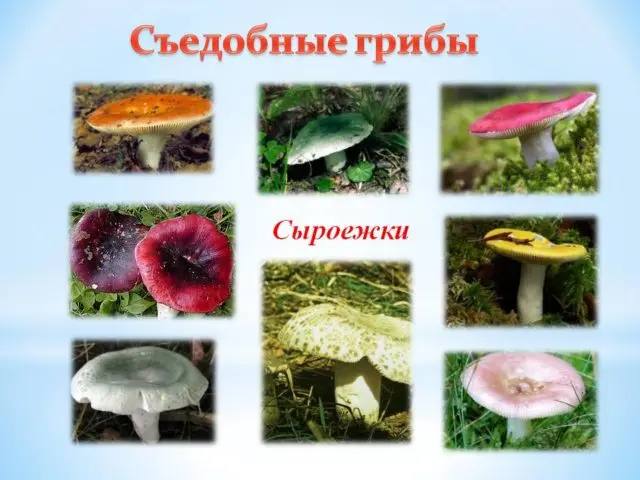
Inedible specimens are determined by the following features:
- bright color of the cap, the predominant shade is red;
- dense pulp that changes color when heated;
- rough plates;
- strong unpleasant odor;
- homogeneous pulp, not damaged by worms.
Such characteristics may also be present in edible species. One way to identify a false specimen is to taste a small piece. If a burning sensation appears in the mouth, such a russula is left in the forest. This method is safe for health if you do not swallow the pulp and rinse your mouth with water. Unpleasant sensations will pass within 5 – 20 minutes.
Difficulties arise with how to distinguish between edible and inedible red russula. The nutritional variety is of the highest value. It is characterized by a duller cap color with a brown, wine, greenish and brown undertone. The leg and pulp are strong, white. This species differs from inedible ones in a pleasant mushroom aroma and nutty flavor.
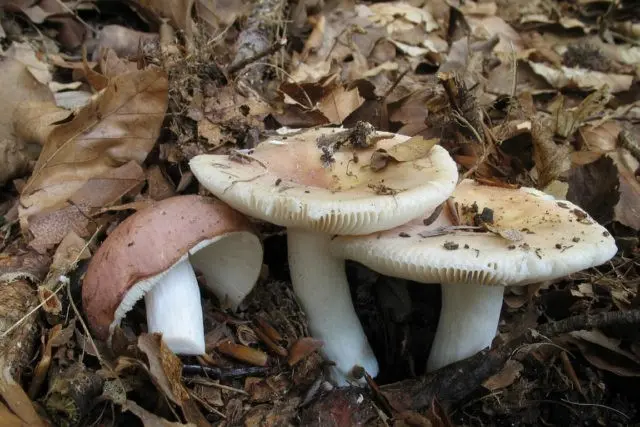
Is it possible to get poisoned with russula
Most false russula have a bitter taste. Even after boiling, stewing, frying and other processing, such a product cannot be eaten. The most dangerous are inedible twins, in which toxins remain in the pulp even after heat treatment.
Poisoning with false russula occurs in the following cases:
- improper handling of the product;
- the pulp contains heavy metal ions or other contaminants;
- exceeding the daily intake of mushrooms;
- long-term storage of the product;
- individual reaction of the organism.
Before cooking, russula is placed in clean cold water. They are kept for 5-6 hours. As a result, toxins that are harmful to human health are removed from the pulp. Water must be drained. Then the mass is placed in a saucepan for boiling. It is poured with cold water and a weak fire is turned on. The minimum cooking time is 10 minutes.
Inedible russula mushrooms absorb metal ions, radionuclides and other contaminants. This product is hazardous to health. Therefore, mushrooms are sent to ecologically clean places. It is not recommended to collect them near highways and industrial facilities.
With excessive use of russula, signs of poisoning often appear: stomach pain, nausea, weakness. Therefore, it is important to observe the daily rate, which is 150 g per day. The product belongs to heavy food, so its use is limited.
After the inclusion of russula in the diet, an individual reaction may occur. The product is taken with caution in the presence of chronic diseases. If there are disorders in the work of the stomach, intestines, kidneys, liver and other organs, first consult a doctor.
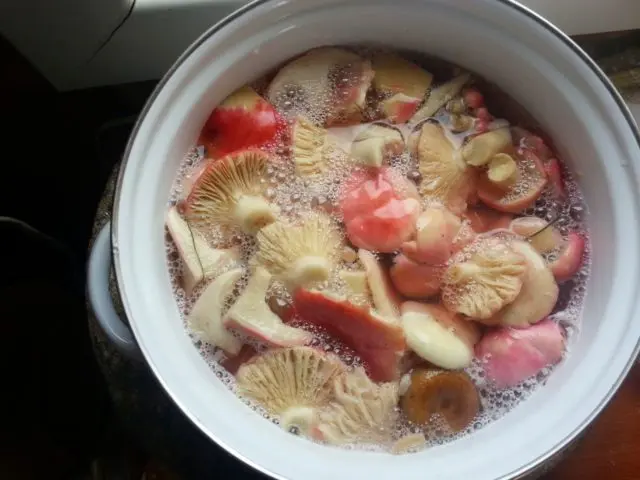
Symptoms and signs of russula poisoning
The first signs of false russula poisoning occur within 30 minutes. Sometimes symptoms may appear later, several hours later. It depends on the age, body weight of a person, the amount and type of mushrooms eaten.
Signs of poisoning with false russula:
- heaviness and sharp pains in the abdomen;
- feeling of dryness and bitterness in the mouth;
- nausea and vomiting;
- high salivation;
- diarrhea.
When poisoned with false mushrooms, the victim feels weakness throughout the body. Often there is dizziness, headache, fever. The body temperature drops, with intoxication liver cells are affected, blood pressure drops.
What to do if you are poisoned by poisonous russula
In case of poisoning with false russula, the victim is given first aid. First of all, it is necessary to remove dangerous substances from the body. To do this, do a gastric lavage and take sorbents. Be sure to call an ambulance. With severe intoxication, treatment is carried out in a hospital under the supervision of a doctor.
Before the doctor arrives, the patient is given first aid:
- give more warm liquid;
- induce vomiting to empty the stomach;
- take activated charcoal, Polysorb or similar drugs;
- the victim is provided with bed rest.
Treatment of poisoning after eating false mushrooms takes several days. In severe cases, this process can take weeks. Dieting helps to speed up the recovery of the body. Heavy foods are excluded from the diet. It is also necessary to drink more liquids: herbal tea or decoctions.
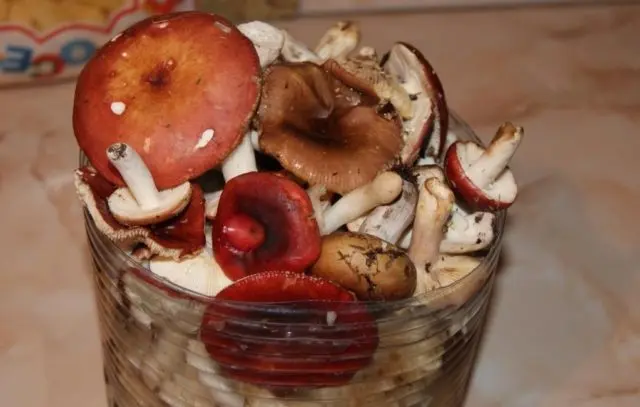
Conclusion
A photo of edible and inedible russula will help mushroom pickers find the differences between them. Useful mushrooms have characteristic features. It is important to know the external features of different types of russula. Among them there are inedible specimens, which are characterized by a bitter taste. The greatest danger is represented by pale grebes and other poisonous varieties of mushrooms.










